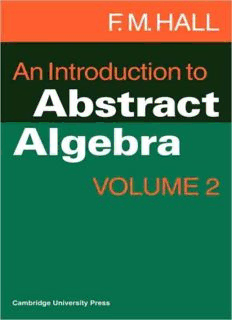
An Introduction to Abstract Algebra (Vol II) PDF
Preview An Introduction to Abstract Algebra (Vol II)
AN INTRODUCTION TO ABSTRACT ALGEBRA AN INTRODUCTION TO ABSTRACT ALGEBRA VOLUME 2 BY F. M. HALL Head of the Mathematics Faculty Shrewsbury School CAMBRIDGE AT THE UNIVERSITY PRESS 1969 CAMBRIDGE UNIVERSITY PRESS Cambridge, New York, Melbourne, Madrid, Cape Town, Singapore, Sao Paulo, Delhi Cambridge University Press The Edinburgh Building, Cambridge C132 8RU, UK Published in the United States of America by Cambridge University Press, New York www.cambridge.org Information on this title: www.cambridge.org/9780521070553 © Cambridge University Press 1969 This publication is in copyright. Subject to statutory exception and to the provisions of relevant collective licensing agreements, no reproduction of any part may take place without the written permission of Cambridge University Press. First published 1969 Re-issued in this digitally printed version 2008 A catalogue record for this publication is available from the British Library ISBN 978-0-521-07055-3 hardback ISBN 978-0-521-29862-9 paperback CONTENTS Preface page x 1 GROUPS 1.1 Introduction-equivalence relations 1 1.2 Algebraic structures 3 1.3 Groups 4 1.4 Standard examples of groups 9 1.5 Transformation groups 14 1.6 Direct products 17 1.7 Generators 18 1.8 Subgroups 18 1.9 Cosets and Lagrange's theorem 21 Worked exercises 24 Exercises 1 A 25 Exercises 1 B 27 2 HOMOMORPHISMS OF GROUPS 2.1 Mappings 29 2.2 Mappings which preserve structure: homomorphisms 31 2.3 The kernel and the image of a homomorphism 36 2.4 Types of homomorphism 38 2.5 Examples of homomorphisms 42 2.6 Sets of homomorphisms and their algebra 47 2.7 Groups of automorphisms 50 Worked exercises 51 Exercises 2A 53 Exercises 2B 55 3 RINGS 3.1 Definition of a ring 56 3.2 Elementary results 59 3.3 Basic types of rings 60 3.4 The additive and multiplicative structures of a ring 62 3.5 Examples of rings 66 vi CONTENTS 3.6 Polynomial rings page 72 3.7 Subrings 77 3.8 Ring-homomorphisms 80 3.9 The ring of endomorphisms of an Abelian group 84 Worked exercises 85 Exercises 3 A 87 Exercises 3B 90 4 FIELDS 4.1 Definition of a field 92 4.2 Elementary properties 94 4.3 Examples of fields 98 4.4 Subfields 102 4.5 Field homomorphisms 103 4.6 The characteristic of a field 104 4.7 Prime fields 107 4.8 Finite fields 108 4.9 Skew fields 114 Worked exercises 115 Exercises 4 A 116 Exercises 4B 118 5 INTEGRAL DOMAINS 5.1 Definition and elementary properties 120 5.2 Examples 123 5.3 Factors, units and prime elements 124 5.4 Prime factorisation 128 5.5 The integers 136 5.6 Domains of polynomials 137 5.7 The characteristic of an integral domain 139 5.8 Gaussian integers 140 Worked exercises 142 Exercises 5 A 144 Exercises 5B 146 6 INVARIANT SUBGROUPS 6.1 Description of the problem 148 6.2 Invariant subgroups 153 6.3 Quotient groups 156 CONTENTS Vii 6.4 Conjugacy page 158 6.5 Examples of invariant subgroups 161 6.6 The centre of a group. Inner automorphisms 165 6.7 The natural homomorphism 166 6.8 The quotient group associated with a given homomorphism 167 6.9 Direct products 170 6.10 Simple groups 171 Worked exercises 173 Exercises 6A 176 Exercises 6B 177 7 IDEALS 7.1 Invariant subgroups of an Abelian group 179 7.2 Ideals 180 7.3 Quotient rings 182 7.4 Examples of ideals 184 7.5 Principal ideals 186 7.6 The natural homomorphism 192 7.7 Ideals in a field 194 7.8 Simple rings 195 7.9 Prime ideals 197 7.10 Maximal ideals 198 Worked exercises 202 Exercises 7A 203 Exercises 7B 206 8 EXTENSIONS OF STRUCTURES 8.1 Introduction and examples 207 8.2 The field of fractions of an integral domain 210 8.3 Transcendental extensions 213 8.4 Algebraic extensions of a field 214 8.5 Finite fields as extensions 218 8.6 The general countable field 220 Worked exercises 221 Exercises 8 A 222 Exercises 8B 223 viii CONTENTS 9 VECTOR SPACES 9.1 Introduction page 225 9.2 Algebraic properties of vectors 227 9.3 Abstract vector spaces 228 9.4 Linear dependence 231 9.5 Bases 233 9.6 Dimension of a vector space 236 9.7 Co-ordinate representation 237 9.8 Examples of vector spaces 239 9.9 Subspaces 240 9.10 Linear manifolds 243 9.11 Linear transformations 244 9.12 Representation of a linear transformation by a matrix 246 9.13 The range and null space of a linear transformation 251 9.14 Inverse transformations 254 9.15 Solution of simultaneous equations 256 9.16 Fields as vector spaces 261 9.17 Vector spaces over rings 263 Worked exercises 263 Exercises 9A 267 Exercises 9B 270 10 GEOMETRICAL APPLICATIONS 10.1 Euclidean geometry 273 10.2 Affine geometry 282 10.3 Projective geometry 283 10.4 Transformations in geometry 285 10.5 Simultaneous equations and geometry 291 10.6 The field of scalars in a geometry 294 .10.7 Finite geometries 295 10.8 Algebraic varieties and ideals 297 Worked exercises 301 Exercises 10A 303 Exercises 10B 307 CONTENTS ix 11 BOOLEAN ALGEBRA 11.1 Introduction-the algebra of sets and the algebra of statements page 311 11.2 Boolean algebra: its definition and basic laws 314 11.3 Simple consequences 321 11.4 Boolean functions and their normal forms 323 11.5 Truth tables 328 11.6 Implication and logical arguments 332 11.7 The representation theorem 337 11.8 Application to circuit theory 338 11.9 Application to probability theory 341 11.10 Lattices 342 Worked exercises 345 Exercises 11 A 348 Exercises 11 B 351 12 FURTHER RESULTS 12.1 Introduction 354 12.2 The isomorphism theorems 354 12.3 Composition series: the Jordan-Holder theorem 356 12.4 Sylow groups 358 12.5 The basis theorem for Abelian groups 359 12.6 Galois theory: the insolubility of the general quintic 360 12.7 Ruler and compass constructions 362 12.8 Symmetric polynomials 363 12.9 Modules 364 12.10 The Krull-Schmidt theorem 365 12.11 Representations of groups and rings 367 12.12 Algebraic topology 368 Answers to Exercises 374 Index 379
Description: